Military Hospital
Military
During the Crimean War public criticism of the Army Medical Service had been growing. Government 'red tape' caused severe delays to the delivery of medical supplies, leaving front-line hospitals greatly under-supplied. The pressure for reform continued after the war was over and, in response, it was decided to build a military hospital in London.
The site chosen was the former location of the Millbank Penitentiary, which had been demolished some years previously. The marshes had been drained and the slums around cleared and the Tate Gallery had been built in the central part of the site, opening in 1897. It was intended to build the new military hospital to the north of the Gallery.
In 1901 an announcement in the British Medical Journal - 'New Guards Hospital at Millbank' - implied at first that the hospital would be for members of the Brigade who were taken ill while performing public duties. But the scope of the hospital widened to include the military sick of the London District, the only qualification for treatment being the past acceptance of the Queen's shilling.
The Queen Alexandra's Military Hospital, known colloquially as 'Millbank', was one of the last general military hospitals to be built on the 'Nightingale' pavilion pattern (later such hospitals either occupied converted premises or were hutted).
The Hospital was opened officially in July 1905 by King Edward VII and his wife Alexandra, and their daughter Princess Victoria, who gave their names to three wards. All other wards were named after those who had won the Victoria Cross, with one exception. The Barry Ward for female officers was named after Inspector General James Barry (1795-1865), an officer who did much to relieve the lot of the soldiers and their families. On his death, Barry was discovered in fact to be a woman (the first female to have qualified in medicine in Britain).
The first patients admitted for treatment were veterans of the Boer War, especially those with wounds caused by dum-dum bullets, which refused to heal, those with heart and respiratory diseases, and those injured while over-enthusiastically fighting soldiers from rival regiments. Those infected with insect-borne diseases while serving overseas were also admitted. Military doctors worked on the causes of such tropical diseases; in 1887 Capt. David Bruce (1885-1931) isolated the organism which caused Malta or Mediterranean fever - named brucella after him - and in 1903 the pathologist Major W.B. Leishman (1865-1926) isolated the parasite causing kala-azar (also known as leishmaniasis).
In 1907 the Royal Army Medical College opened on the south side of the Tate Gallery. (The Army Medical School had moved from Netley, Southampton, in 1902 to temporary quarters at St Irvine's Court Hotel until the new premises at Millbank were available).
A Chapel was built in 1909 funded entirely by a Mr Francis Gregson. An organ was installed, also privately funded by a second donor.
During WW1 'Millbank' became a general hospital for the Army. Apart from the war wounded, it received cases of trench-fever, frostbite, shellshock and gas gangrene. During one winter several Highlanders were admitted with lacerations to the backs of their knees, caused by the swing of frozen, mud-caked kilt pleats.
After the war the Hospital was enlarged to 200 beds and, together with the Royal Army Medical College, became the postgraduate school for medical officers of the Royal Army Medical Corps and of the Dominions, as well as for its sister services, the Navy and Air Force. It was the only institution that taught military surgery.
Traditionally, close ties had developed with the Westminster Hospital and the Army Medical Service, and a neoplastic clinic was held jointly by both hospitals.
During WW2 the Hospital was particularly vulnerable because of its proximity to that great landmark from the air, the River Thames, but the buildings received only superficial damage from bombing in 1940.
Following the war a vascular surgical unit was set up in liaison with St Mary's Hospital, Praed Street. Postgraduate training continued for Army medical officers in surgery, tropical diseases and pathology, while Other Ranks received technical training. Teaching rounds were held regularly, with trainees seconded in rotation from the London teaching hospitals.
In 1957 the Hospital was extended to 300 beds; there were two operating theatres and 11 wards (one for children). Patients were allowed one bottle of beer a day, but anything stronger required three official signatures. Male nurses belonged to the Royal Army Medical Corps (RAMC) and female nurses to the Queen Alexandra Royal Army Nursing Corps (QARANC).
It closed as a military hospital during the 1970s, when the Queen Elizabeth Military Hospital was built at Woolwich. Services and staff were transferred to that site.
Although some of its staff also transferred to Woolwich, the Royal Army Medical College remained at Millbank until teaching moved to Portsmouth in 2005.
Present status (December 2008)
Although it is in a conservation area and surrounded by Grade II and II* listed buildings, the former Hospital remains an 'Unlisted Building of Merit'. Some buildings were demolished so that an extension to the Tate Gallery could be built.
Since 1982 the remaining buildings have housed various administration departments of the Tate as well as the library, meeting rooms and the conservation science section.The chapel remains but its stained glass window, depicting the Ascension of Jesus Christ, was removed to the Queen Elizabeth Military Hospital, Woolwich.
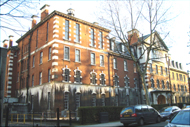
The northeast block on John Islip Street, opposite the end of Marsham Street, is now used for various Tate offices.
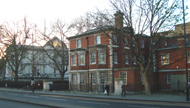
Along Millbank the former Hospital Lodge is seen in with Tate Britain beyond.

The Lodge is situated between the end of the Tate Gallery extension (left) and Millbank itself. It is still called 'The Lodge' and now contains the Director's office.
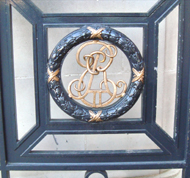
The gates of the Lodge from Millbank appear to be Hospital-based, with a stylized 'QA' monogram in ironwork.
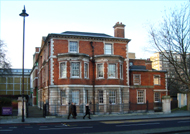

The entrance to the Military Sisters Nursing Home at 20 John Islip Street. The gable bears a stylized Coat of Arms with a cross and a 'T', and the motto 'sub croce candida'.
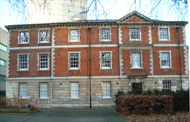
The Lodge
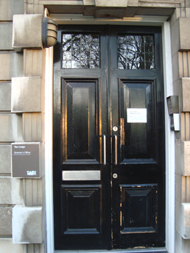
The front door of the Lodge
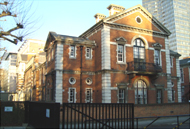

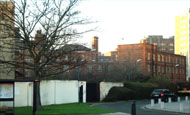
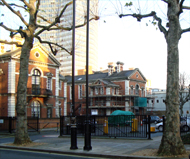
The College buildings were taken over by the Chelsea College of Art and Design in 2005.


The view from Millbank
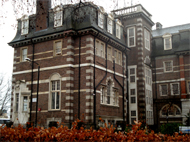
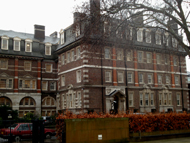

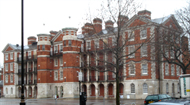

(Author unstated) 1957 Queen Alexandra's Military Hospital. Hospital and Health Management (May), pp. 166-167.
Crispin P 1962 'Millbank'. The Vickers magazine, pp. 9-12.
Richardson H (ed) 1999 English Hospitals 1660-1948: A Survey of their Architecture and Design. Swindon, Royal Commission on the Historical Monuments of England.
www.driversjonas.com
www.qaranc.co.uk
www.tate.org.uk
www3.westminster.gov.uk
Return to home page